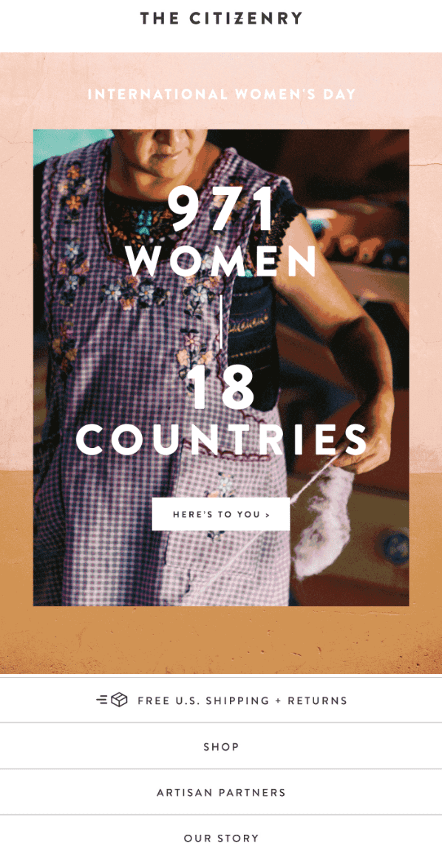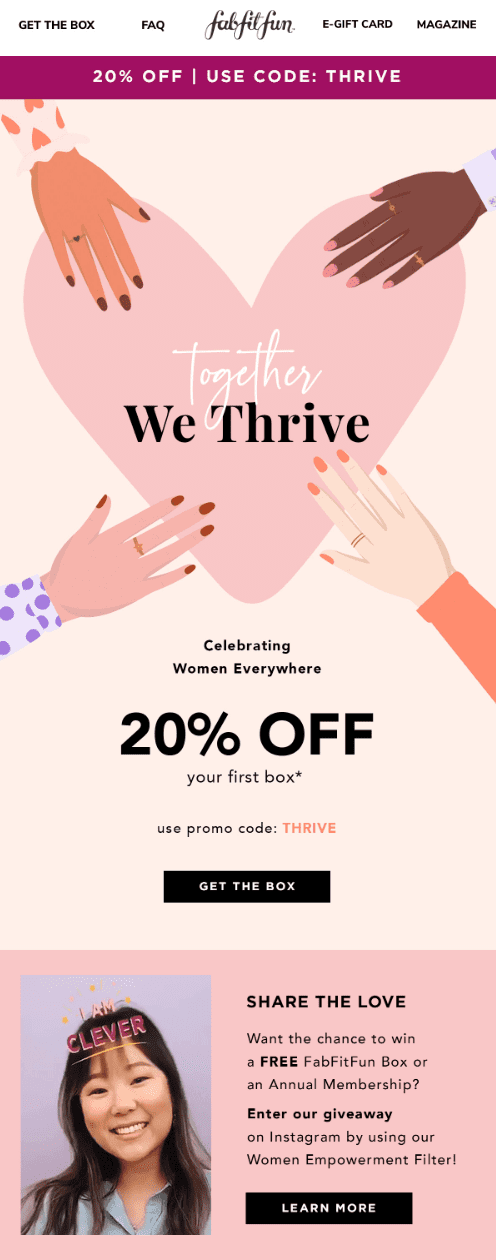March is Women’s History Month. It’s also home to International Women’s Day (IWD). As such, March gives marketers an opportunity for impact—to magnify the accomplishments of women and work to end gender discrimination, bias and inequities.
But before we jump into email marketing examples, it’s critical to understand how Women’s History Month and International Women’s Day align and diverge.
While both holidays recognize women, International Women’s Day on March 8 is a celebration of women’s cultural, political and social achievements around the world and highlights the continuing challenges and roadblocks that hinder gender equity and justice.
Women’s History Month also recognizes that women, especially women of color, have been excluded or written out of history. Women’s History Month is all about educational programs and empowerment to correct the record while also celebrating progress and achievement.
Here’s some history:
- International Women’s Day is rooted in a 1908 protest march in New York City organized by women workers seeking better jobs, pay and working conditions and was first celebrated as National Women’s Day in 1909.
- The event became an international movement at the International Women’s Conference in Copenhagen in 1910 and later proclaimed a holiday by European countries, including Russia, the first major European country to grant women the vote.
- Women’s History Month began in 1978 as Women’s History Week, part of a school curriculum project inspired by International Women’s Day.
- Support for the movement led to creating National Women’s History Week in 1980 under President Jimmy Carter and National Women’s History Month in 1987.
Focus Your Campaigns on Women
Focusing your email marketing campaign on themes of equality, equity, education and empowerment this season will contribute directly to the causes, while helping your brand connect with customers in a meaningful way.
Customers want brands to take public stands on social issues and will ally with brands whose values they share.
Here are three nuanced, but connected approaches you can take your marketing messaging this March that will make an impact and leave an impression.
1. Honor women customers
Women still control the majority of household spending and do 89% of the daily shopping. And, while women aren’t the only ones who have suffered stress and burnout during the pandemic, studies like McKinsey’s Women in the Workplace 2020 suggest that women have shouldered a greater share of the household and childcare burden. Thanking them for supporting the brand lets them know you appreciate them.
2. Spotlight women employees
A growing number of brands feature pictures, stories and quotes from women employees across the organization, not just those in customer-facing roles.
3. Highlight company efforts to support women’s initiatives
An IWD or Women’s History Month campaign can build brand equity by showing how your company addresses gender equity, supports its women employees and contributes to local and national efforts.
3 Tips to Create a Meaningful Campaign for Women’s History Month
Now that you have the direction, you’ll need guidance. Here are some handy tips to create a compelling cause-driven campaign:
1. Don’t mix your messages
It takes more than a “Happy International Women’s Day” banner on a standard promotional email to position your brand as an empowering ally. Be mindful of the copy you use to promote sales and products. Be especially intentional with your subject lines, headers and calls to action.
2. Make women the focus of your campaign, not your business
If your company has an authentic message, success story or cause-driven campaign to share, be sure to share it through the eyes of the women who benefit from your message, or the woman who is sharing the story. That’s who your customers really care about.
3. Drive long-term change with your messaging
Have we made progress since women marched for workers’ rights back in 1908? Of course. But we still have a long way to go. Last year, the World Economic Forum’s Global Gender Gap Report for 2020 predicted that gender parity is at least another 100 years away.
Combine this disappointing data-point with the recent news that the COVID-19 pandemic could set progress for women back at least five years: Women lost disproportionately more jobs and, as we mentioned above, shouldered even more of the household burden.
This means that we have to push harder for change, and the campaigns your email marketing team creates for International Women’s Day and Women’s History Month can play a pivotal role in that progress.
Examples of Great Email Campaigns
Our review of International Women’s Day and Women’s History Month emails showed us that marketing teams are becoming more mindful about the messages they’re sending out for these campaigns. These examples show how you can create a meaningful message.
Verishop
Verishop is one of the few brands to do a concerted campaign series for Women’s History Month. The message below shows how to create a brand message that tells its story from the woman’s perspective using her own words.


Image via MailCharts
By limiting promotional messages to just the calls to action, this email keeps the focus on the inspirational content but subtly encourages readers to click to the website to check out McNamara’s products.
Brooklinen
Brooklinen puts its cause—supporting women in technology—front and center in its International Women’s Day Campaign. It highlights the initiative, promotes its fundraiser while explaining where it will spend the proceeds, and shines a spotlight on an employee (from the email team! Yeah!).


Image via MailCharts
You can’t see it in this image, but Brooklinen uses the email preheader to state its commitment to support its predominantly women workforce: “We’re empowering and celebrating women today, and everyday.”
MeUndies
MeUndies’ vibrant message caught our eye because it didn’t stoop to cutesy or trendy identifiers like “girlboss,” “girl power” or “she-ro.” Its size-inclusive models reinforce the company’s message that there’s no longer a single standard for acceptable images.


Image via MailCharts
MeUndies’ email is a great example of “appointment email.” It tells the reader to expect more emails like it, which can lead interested customers to start watching the inbox for the next message in the series—a great way to help the email stand out!
Zenni Optical
If you want to connect with your customers and show how your company supports them, make them the star of your email. This customer-first approach combines an inspirational message with a reason to move customers to the website to browse around.


Image via MailCharts
Zenni’s email keeps the focus on the customer, but the message design moves the eye right down to the bottom of the email to the company values statement.
The Citizenry
This home décor brand incorporates a cross-cultural theme in its brand identity. So, presenting an animated series of images of the women who make its products is a meaningful and on-brand message.


Image via MailCharts
The subject line—”Meet the 971 ladies of The Citizenry.”—hints at what’s inside the message, but the preheader spills the beans: “The Citizenry Meet the makers.”
FabFitFun
FabFitFun’s email creative is a timely reminder that an effective women-focused message should incorporate your other inclusive values, like the hero image showing different skin tones and an animated series of GIFs featuring women of different ethnic backgrounds.


Image via MailCharts
FabFitFun’s message is more promotional than other examples, but it’s also a good example of a message in which all the elements reinforce the International Women’s Day theme, right down to the “Women’s Empowerment Filter” and the “Thrive” promo code.
Before You Plan Your Women’s History Month Campaign
Your starting point for planning a campaign starts from within. Use the advice we shared for a cause-driven marketing campaign during Black History Month as a foundation for your mission-centric marketing education.
Think of these campaigns as alliances with the cause instead of an event to co-opt for a one-off campaign. Your company’s track record for closing pay and leadership gaps, meeting women workers’ unique needs, rejecting harassment and discrimination, and supporting charities that benefit girls and women comes into play.
But what do you do if your company’s support of women falls short of customer expectations? You’ll need to focus on incorporating content that honors women but also avoids performative allyship, or espousing values to look good in public without backing them up in private. Keep in mind that progress is gradual. This is a good starting point for your brand.
These resources can help you understand more about International Women’s Day and Women’s History Month:
- International Women’s Day
- Women’s History Month
- National Women’s History Alliance
- EdSITEment (National Endowment for the Humanities)
Ready to Dive in? It’s OK to Smart Small
Begin with an International Women’s Day campaign, maybe one that follows an example from the emails we suggested above. From there your company can work internally to support women in their workplace, and you can start to focus on expanding your initial email investment.
After a little time, perhaps you can grow to embrace and deploy a multi-email campaign that highlights your successes or focuses on issues relevant to women.































